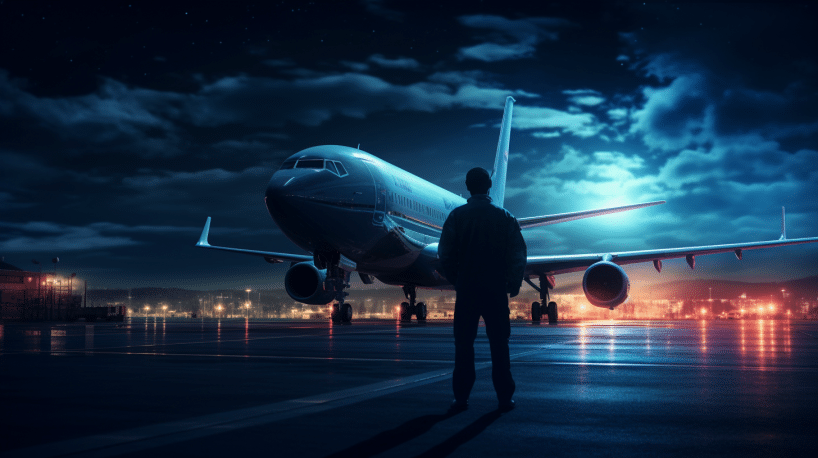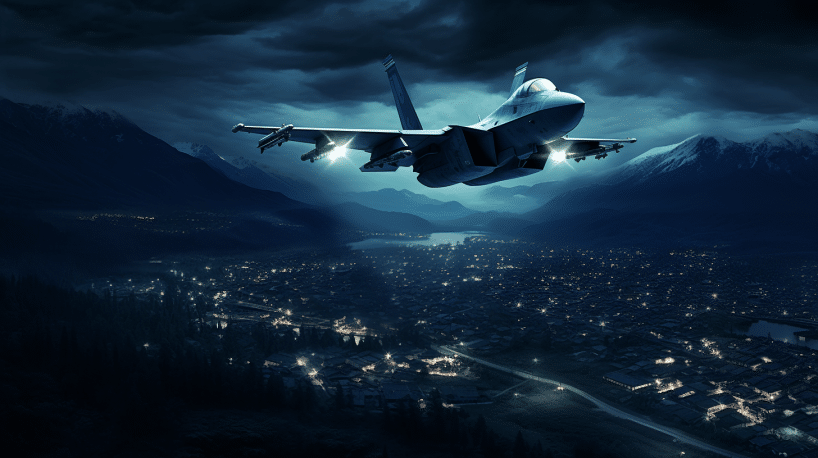Staying awake and alert can be challenging, especially for pilots working long hours and night shifts.
A new study found that the drugs modafinil and caffeine can significantly improve vigilance in pilots compared to placebo, helping them stay alert and attentive during periods of sleep deprivation.
Key Facts:
- The study tested 32 pilots from the Royal Netherlands Air Force after ~17 hours of wakefulness.
- Pilots were given either 200 mg modafinil, 300 mg caffeine, or placebo before doing reaction time and vigilance tests.
- Both modafinil and caffeine significantly improved reaction times, vigilance, and alertness compared to placebo.
- The effects were most notable 2-4 hours after taking the drugs.
- Modafinil’s effects lasted longer than caffeine, up to 8 hours after administration.
Source: Pharmaceuticals (Basel). 2023 Aug; 16(8): 1067.
Fighting Fatigue in Aviation
Fatigue due to sleep deprivation is a major risk factor for aviation accidents.
Studies show 21-24% of major crashes can be attributed partly to pilot fatigue. With long duty hours and overnight flights, pilots often have to work when their bodies want to sleep.
This impairs their attention, vigilance, and performance. Finding ways to counteract fatigue is critical for flight safety.
The International Civil Aviation Organization defines fatigue as “a physiological state of reduced mental or physical performance capability resulting from sleep loss, extended wakefulness, circadian phase, and/or workload”.
Sleep loss prior to flying is one of the biggest causes of fatigue.
Stimulant medications like modafinil and caffeine may help pilots stay alert by reducing the effects of sleep deprivation on the brain.
But it’s unclear how well they work after only 17 hours awake, which is a typical scenario for military pilots on missions.
This new study provides important data on their effectiveness during a realistic period of wakefulness.
Testing Stimulants on Pilots
The researchers recruited 32 healthy pilots from the Royal Netherlands Air Force.
Their average age was 35 years old. On 3 different nights, the pilots were randomly given either 200 mg of modafinil, 300 mg of caffeine, or placebo.
The moderate doses represented realistic amounts pilots may take operationally.
After staying awake for around 17 hours, they took the assigned medication right after midnight.
Over the next 8 hours, the pilots performed two 10-minute cognitive and reaction time tests six times each to measure effects on vigilance and alertness.
The tests involved tracking objects on a screen and responding to visual stimuli as quickly as possible.
The pilots also rated their subjective sleepiness levels on a scale from 1-7.
Blood samples were taken to confirm modafinil and caffeine concentrations. The crossover design allowed comparisons of all three drug conditions in the same individuals.
Results: Drugs Beat Placebo
Compared to placebo, both modafinil and caffeine significantly improved performance on the reaction time and vigilance tests.

The effects began 2 hours after taking the drugs and peaked after 4-6 hours. The differences compared to placebo were statistically significant.
Specifically, both drugs reduced average reaction times, attentional lapses, tracking errors, and misses on the vigilance tests.
The pilots also reported feeling less sleepy after taking modafinil and caffeine based on the subjective scales.
The boosts in performance demonstrate the stimulants helped the pilots overcome deficits from sleep deprivation better than placebo.
The timing coincides with when modafinil and caffeine reach peak blood concentrations after oral ingestion.
Modafinil Lasts Longer Than Caffeine
An interesting finding was modafinil’s effects seemed to persist longer than caffeine.
At 8 hours after administration, modafinil still significantly enhanced reaction times and vigilance compared to both caffeine and placebo.
This prolonged benefit is likely due to modafinil’s longer half-life of around 15 hours, compared to just 4-6 hours for caffeine.
With its extended effects, modafinil may be the better choice when pilots need to stay alert for night missions over 8 hours long.
Overall, the study confirms both modafinil and caffeine counteract deficits in alertness and performance from sleep loss in pilots.
This could have major implications for aviation safety, military operations, and other occupations requiring vigilant attention at odd hours.
Optimizing Stimulant Use in Aviation
More research is still needed to refine stimulant use in pilots.
The benefits in this controlled study should be verified in real flight conditions.
The interaction between the drugs and prior caffeine use also needs investigation.
Since many pilots habitually consume caffeine, they may build tolerance and experience less efficacy from additional doses.
Understanding the impact of individual differences in sleep patterns and sleep debt would also help optimize stimulant strategies.
The pilots had varying amounts of sleep the nights before testing.
Accounting for this variability could improve predictions of performance impairment and responses to stimulants.
Ideally, stimulants should be combined with other fatigue prevention methods like adjusted work schedules, controlled rest periods, and in-flight countermeasures.
Used properly, they provide a supplemental line of defense against the threats of fatigue and drowsiness while flying.
The Risks of Flying Fatigued
Why is fatigue so problematic for pilots? Mental deficits from sleep deprivation degrade the skills necessary to fly safely.
Research shows fatigued pilots have:
- Slower reaction times and information processing
- Impaired coordination and motor control
- Worse attention, vigilance, and memory
- Increased distractibility and mind wandering
- Reduced situation awareness and risk perception
- Increased errors during critical phases like takeoff and landing
- More microsleeps and uncontrolled nodding off
These mental lapses multiply the chances of pilot mistakes that can lead to accidents or incidents. Fatigue undermines the situational awareness and split-second reactions needed to operate aircraft safely.
Fatigue-related impairments also compound over successive days of restricted sleep. Cumulative sleep debt worsens the effects. Taking stimulants prevents degradation of abilities that are essential for aviators.
The Dangers of Flying at Night
Night flights are particularly problematic. Humans are programmed to sleep at night due to circadian rhythms.
Alterations to the sleep/wake cycle from overnight flights disturb the body clock and internal regulation of alertness.
During the Window of Circadian Low (WOCL) around 2-6 AM, drowsiness and performance deficits are maximized as the body expects to be sleeping.
Long nighttime duties stretching into the WOCL substantially raise the risks of fatigue-induced errors.
Taking stimulants provides chemical assistance to overcome circadian challenges during night flights.
They help pilots resist the mounting urge to sleep when deprived at an adverse circadian phase.
Supplemental stimulants are an advantage for beating the combined effects of prolonged wakefulness and circadian misalignment.
Modafinil vs. Caffeine
The two stimulants have slightly different properties that are useful to understand:
Modafinil is a eugeroic drug, meaning it promotes wakefulness and alertness.
- Its exact mechanisms are not fully known but likely involve multiple neurotransmitters.
- It elevates histamine, dopamine, norepinephrine, serotonin, glutamate, and orexin levels in the brain.
- Modafinil is approved to treat narcolepsy and shift work sleep disorder.
Caffeine is the world’s most consumed psychoactive drug.
- It blocks adenosine receptors to inhibit sedation and promotes cortisol and catecholamine release.
- Caffeine is found naturally in coffee, tea, and cocoa plants. It’s added to many processed foods, beverages, and medications.
In the study, modafinil took longer to kick in but lasted longer. Caffeine acted sooner and gave a couple hours of benefit.
The differences correspond to their pharmacokinetics:
- Modafinil takes 2-4 hours to reach peak plasma levels and has a half-life around 15 hours.
- Caffeine reaches peak plasma levels in 30-120 minutes and has a shorter half-life of just 4-6 hours.
For maximum alertness during a full overnight shift, modafinil may be preferable to avoid caffeine wearing off.
Caffeine could be better for a quick pick-me-up on shorter flights.
Fighting Fatigue Beyond Aviation
Pilots aren’t the only ones who have to perform critical tasks while sleep deprived.
The anti-fatigue benefits of stimulants extend to many professions and situations:
- Healthcare workers – Surgeons, ER doctors, nurses, and other hospital staff frequently work overnight shifts when the body craves sleep. Mistakes due to grogginess put patients at risk.
- Long-haul truckers – Drowsy driving causes hundreds of heavy truck accidents every year. Stimulants help drivers stay alert on endless highways late at night.
- Military personnel – Troops deployed in combat zones or on overnight operations need to maintain vigilance when sleep is limited. Their safety and mission depend on being mentally sharp.
- Shift workers – Employees doing manual labor or operating heavy machinery are vulnerable to fatigue on overnight schedules. Stimulants provide a defensive safety net.
- Students – Those cramming all night to finish projects or study for exams can use stimulants to improve focus and cognition temporarily when sleep isn’t possible.
The strategic use of stimulants allows people in high-risk, demanding occupations to overcome the perils of fatigue due to unusual work hours.
With proper dosing and timing, they provide a pharmacological aid to sustain performance in the face of sleep deprivation.
Of course getting healthy regular sleep will always be the ideal solution.
References
- Study: Effects of modafinil and caffeine on night-time vigilance of air force crewmembers: A randomized controlled trial
- Authors: Yara Q. Wingelaar-Jagt et al. (2023)







